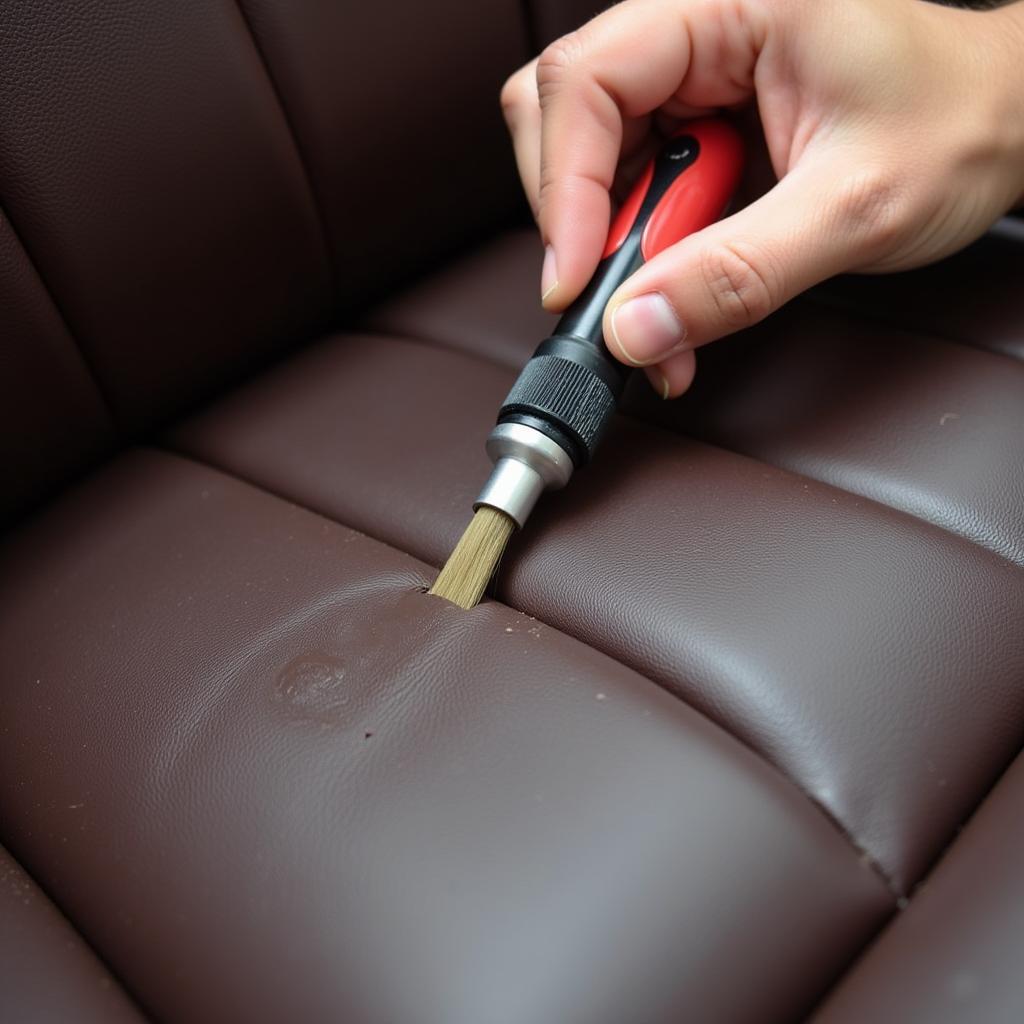Leather car interiors exude luxury and comfort, but over time, they can show wear and tear. “How Do You Fix Undone Leather In Cars?” is a common question for car owners seeking to restore their vehicle’s interior. Whether it’s cracks, scratches, or sagging, understanding the right techniques and materials is crucial for a successful repair. Addressing these issues promptly not only improves the aesthetics but also prevents further damage and maintains the car’s resale value.
Identifying the Leather Damage in Your Car
Before diving into the repair process, it’s essential to assess the specific type of damage your leather car interior has sustained. This will dictate the appropriate repair method. Common leather issues include cracks, scratches, tears, fading, and stains. Accurately diagnosing the problem will ensure you use the right products and techniques, ultimately leading to a more effective and long-lasting repair.
Cracks and Scratches: Common Leather Wear and Tear
Cracks and scratches are the most frequent types of leather damage, often caused by friction, sun exposure, and general wear and tear. Minor surface scratches can often be addressed with leather conditioners and cleaners. Deeper cracks, however, may require fillers and specialized repair compounds.
 Repairing Cracks in Car Leather
Repairing Cracks in Car Leather
Tears and Holes: Addressing More Severe Leather Damage
Tears and holes require a more involved approach. Patching and stitching might be necessary for larger tears, while smaller ones can sometimes be repaired with liquid leather or adhesive fillers. Choosing the right repair method depends on the size and location of the tear.
Fading and Discoloration: Restoring Leather’s Vibrancy
Sun exposure can cause leather to fade and lose its original color. Specialized leather dyes and color restorers can help revive the leather’s vibrancy. It’s crucial to choose a dye that matches the original color as closely as possible.
How to Repair Undone Leather: Step-by-Step Guide
Once you’ve identified the type of damage, you can begin the repair process. Here’s a step-by-step guide to help you fix undone leather in your car:
-
Clean the Area: Thoroughly clean the damaged area with a dedicated leather cleaner to remove dirt and debris.
-
Prepare the Leather: If necessary, use a leather deglazer to remove any existing sealant or finish.
-
Repair the Damage: Apply leather filler to cracks or tears, smoothing it out with a spatula. For tears, consider using a leather patching kit.
-
Sand and Smooth: Once the filler is dry, sand the area smooth using fine-grit sandpaper.
-
Apply Leather Dye (if needed): If the leather is faded or discolored, apply a leather dye that matches the original color.
-
Condition and Protect: Apply a leather conditioner to moisturize and protect the repaired area.
Professional Help: When to Seek Expert Assistance
While minor leather repairs can be DIY projects, more extensive damage often requires professional expertise. Don’t hesitate to seek professional help for significant tears, deep scratches, or widespread damage.
“A professional detailer can bring the right tools, experience, and expertise to ensure a perfect repair,” advises John Davis, a seasoned automotive leather repair specialist. “They can also advise on preventative measures to keep your leather in top condition.”
Maintaining Your Car’s Leather Interior
Preventing future damage is as important as fixing existing issues. Regular cleaning and conditioning are essential. Use a dedicated leather cleaner and conditioner to keep the leather supple and protected. Avoid exposing your car to direct sunlight for extended periods, and use seat covers if necessary. “Regular maintenance is key to preserving the beauty and longevity of your car’s leather interior,” adds Sarah Miller, an automotive upholstery expert. “Just like regular oil changes, consistent leather care is an investment that pays off in the long run.”
Conclusion
Fixing undone leather in cars requires careful assessment, the right materials, and patience. Whether it’s minor scratches or more significant tears, understanding the repair process and knowing when to seek professional help can restore your car’s interior to its former glory. By following the steps outlined above and maintaining a regular cleaning and conditioning routine, you can keep your car’s leather looking its best for years to come. For expert assistance or if you have further questions, please connect with us at AutoTipPro. You can reach us at +1 (641) 206-8880 or visit our office at 500 N St Mary’s St, San Antonio, TX 78205, United States.
FAQ
-
What’s the best way to clean car leather? Use a dedicated leather cleaner and a soft microfiber cloth.
-
Can I use household cleaners on car leather? Avoid using household cleaners as they can damage the leather.
-
How often should I condition my car leather? Condition your leather every few months, or more frequently in harsh climates. fixing ripped car seat
-
Can I repair a tear in my car leather myself? Minor tears can be repaired with DIY kits, but larger tears often require professional help.
-
How can I prevent my car leather from fading? Park in shaded areas, use window shades, and apply a UV protectant.
-
What should I do if I spill something on my car leather? Blot the spill immediately with a clean cloth and avoid rubbing. fixing ripped car seat
-
How much does professional car leather repair cost? The cost varies depending on the extent of the damage and the type of repair needed.




Leave a Reply